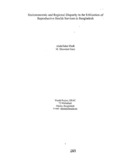| dc.contributor.author | Hadi, Abdullahel | |
| dc.contributor.author | Gani, Md. Showkat | |
| dc.date.accessioned | 2019-11-21T06:14:19Z | |
| dc.date.available | 2019-11-21T06:14:19Z | |
| dc.date.issued | 2002 | |
| dc.identifier.citation | Hadi, A., & Gani, M. S. (2002). Socioeconomic and regional disparity in the utilization of reproductive health services in Bangladesh. Research Reports (2002): Health Studies, Vol - XXXII, 265–290. | en_US |
| dc.identifier.uri | http://hdl.handle.net/10361/13058 | |
| dc.description.abstract | Although the health care system has significantly expanded in Bangladesh during the last two decades,
the health status of the population has remained very poor because .of the uneven distribution of health
services. Inequality in health exists in many forms and multiple dimensions such as age, gender,
economic, ethnicity, class, etc. Using data from a nationally re'presentative sample, this study attempts to
improve our understanding about the socioeconomic and regional disparity in the utilization of
reproductive health services in Bangladesh.
Data for this study came from the demographic and health surveillance system of BRAe which
provided the updated information of the ownership of household asset. Socioeconomic disparity was
measured by constructing a wealth index using compound assets and possessions of a set of household
assets based on which the households were classified into wealth quintiles. The surveillance areas were
categorized into four regions as urban, rural under-served, other rural and the hill tracts. The utilization
of reproductive health services was measured by the access to ante and postnatal care, maternal
immunization, and safe delivery. A total of 1,182 women were interviewed who gave birth in 200 I were
selected at random.
Findings revealed significant household and regional differentials in the use of reproductive
health services. The use of health services was much lower among the extreme poor than the non-poor
and among the ethnic minorities in the hill and under-served than the other regions. While socioeconomic
differentials in the utilization of health services by age, education, land ownership were noticeable, the
use of services among women involved in NGO program was found significantly higher than those not
similarly involved.
Multivariate analysis identifies that older and illiterate women from the extreme poor households
who lived in the traditionally under-served region and not involved in NGO-Ied development program
were the most deprived and vulnerable groups in receiving reproductive health services. The probability
to receive services. however, is likely to significantly increase after involving in NGO-Ied program. The
study argues that targeted development intervention has the potential to significantly reduce both the
socioeconomic and regional inequality in the utilization of reproductive health services in Bangladesh. | en_US |
| dc.language.iso | en | en_US |
| dc.publisher | BRAC Research and Evaluation Division (RED) | en_US |
| dc.subject | Regional disparity | en_US |
| dc.subject | Reproductive health | en_US |
| dc.subject | BRAC | en_US |
| dc.subject | Poor | en_US |
| dc.subject.lcsh | Reproductive health -- Bangladesh. | |
| dc.subject.lcsh | Non-governmental organizations -- Bangladesh. | |
| dc.subject.lcsh | Health, Nutrition, and Population Program (BRAC) | |
| dc.title | Socioeconomic and regional disparity in the utilization of reproductive health services in Bangladesh | en_US |
| dc.type | Research report | en_US |

